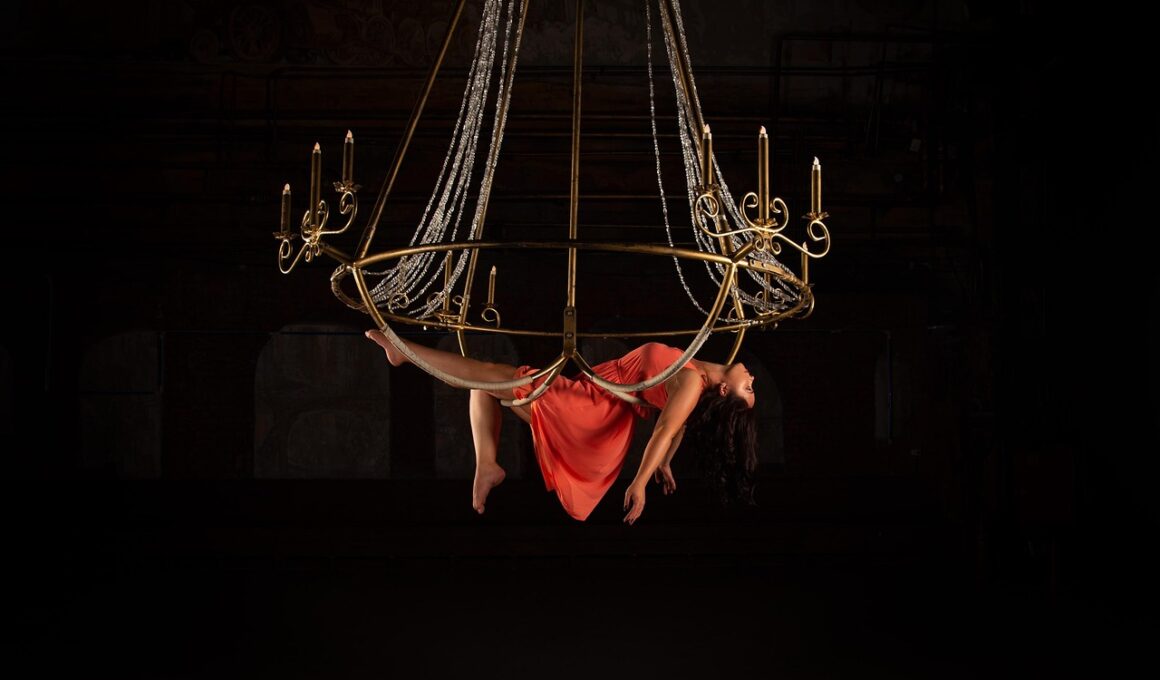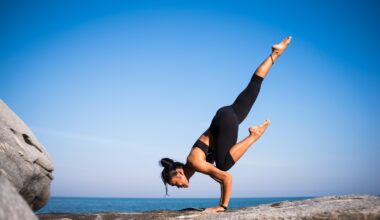Safety Tips for Practicing Aerial Fitness in Group Classes
Aerial fitness incorporates unique apparatuses such as silks, hammocks, and hoops, which introduce dynamic movements and poses. However, safety should always remain the priority. First, ensure that your equipment is properly maintained and regularly checked for wear and tear. Look for frays or tears in fabric and sturdy attachments before class. Additionally, listen attentively during instructor briefings, as they may offer critical information about transitioning into aerial moves safely. Understanding how to grip, mount, and dismount from your aerial apparatus is essential. Wear appropriate, form-fitting clothing that allows for movement without getting caught in the apparatus. Avoid jewelry that could snag or cause injury during your routines. It’s equally important to stay hydrated and warmed up before jumping into aerial activities. Your body should be prepared to handle the unique strain of climbing, hanging, and balancing. Always communicate with your instructor about any pre-existing conditions or injuries, and do not push beyond your limits, especially in a group setting where others may be attempting similarly challenging poses.
Warm-ups can significantly help avoid injuries in aerial fitness classes. A comprehensive warm-up typically includes dynamic stretching and mobility exercises to prepare your muscles and joints. It’s suggested to spend a good 10-15 minutes warming up before engaging in any aerial activities. Pay special attention to your shoulders, core, and hips, as these areas are heavily utilized during aerial maneuvers. Also, practicing foundational movements regularly will enhance your strength and stability, thus reducing injury risks. Focus on mastering basic poses and transitions before advancing to more complex routines. This not only builds the necessary confidence but also reinforces proper technique. When practicing in a group, observe others and take cues to match their movements. However, remember that each individual’s body is different; don’t compare your progress against theirs. If something feels off, either in a pose or during practice, don’t hesitate to ask for assistance. Always practice spot safety in group classes. By advocating for each other’s safety and creating a supportive environment, instructors can help ensure everyone feels comfortable exploring aerial practices.
Understanding Group Dynamics in Aerial Classes
Being in a group class allows for motivation and camaraderie, but it also presents unique challenges. One important aspect to remember is maintaining personal space. With aerial apparatus suspended around, it is crucial that practitioners honor each other’s boundaries, ensuring there’s enough room to avoid collisions. Focus on your execution and how you interact with the space around you. It’s beneficial to develop awareness of your surroundings, especially if fellow participants are performing intricate moves. Always respect personal limits; no one should feel pressured to attempt a pose or move that they are not comfortable with. Collaborative support is key; instead of competition, foster an encouraging atmosphere. Seek and offer guidance throughout practice, as feedback from peers can lead to improvement and increased confidence. Additionally, perceptions of safety may vary from individual to individual, so discuss potential concerns with your instructor beforehand. Keep communication open and honest about both fears and progress. Group dynamics can greatly influence the overall experience, so be attentive and adapt as needed to create an inclusive environment for all.
Wear appropriate gear when attending aerial fitness classes to ensure safety. Specific clothing, such as long-sleeved shirts and form-fitting pants, provide both comfort and protection while reducing the risk of slipping or snagging in the apparatus. Avoid thick clothing that may lead to overheating or restrict your movements. Footwear is another topic; most aerial classes encourage participants to practice barefoot to improve grip and connectivity with the apparatus. Be considerate of hygiene, and ensure that your feet are clean before class. Arrive on time to warm up properly and set up your equipment without disrupting others. Always inform your instructor of any medical conditions, especially past injuries that may affect your ability to perform specific movements. Consistent practice is key; however, also take rest days to allow your muscles to recover and grow stronger over time. Analyze your progress by tracking improvements or areas needing more work. Ideally, find balance and moderation throughout your aerial journey. With the right gear and habits, aerial classes can be not only fun but also efficient for building strength and flexibility.
Ensuring Equipment Safety
Equipment checks prior to class are essential for maintaining safety during aerial practices. Aerial silks, hoops, and trapeze need to be properly rigged to ensure both security and functionality. Before each class, visually inspect rigging points, adjustments, and apparatuses. Confirm that all knots and configurations are in place and tight enough to handle movement without risk of failure. Regular maintenance processes conducted by experienced instructors are crucial for participant safety. Attend classes at facilities that prioritize equipment quality and regularly inspect their installations. In addition to standard checks, ensure that you adhere to guidelines regarding how much weight your apparatus can safely handle. Do not exceed recommended limits; failing to adhere to these guidelines can result in severe injuries and jeopardize group class safety. Request additional guidance if you’re unsure about handling or installing any equipment. Rely on the instructor’s expertise not only for learning aerial techniques but also for safety protocols. Lastly, properly store the equipment after use to keep it in good condition for future classes. Taking these preventive measures fosters an environment where everyone can thrive.
Always focus on posture and alignment while practicing aerial fitness, as these motions can greatly affect your safety. Proper posture helps to distribute weight evenly throughout your body, reducing strain on muscles and ligaments. Engage your core throughout the practice, leading to greater stability and control during various poses. Understanding the mechanics of body alignment is essential in avoiding injuries during challenging routines. Always attempt transitions and movements slowly, allowing your body to adjust before progressing. If you’re learning a new pose, be patient and take the time necessary to find your balance; rushing can lead to mistakes and injuries. Consider using mats or additional safety gear if offered, especially for beginners or advanced moves. Instructors may demo techniques, but watching and internalizing the movements for yourself is just as vital. Visualization can greatly aid understanding and confidence while practicing. It promotes stronger engagement and prepares the body for physical challenges ahead. Finally, be kind to yourself throughout this journey; aerial fitness is demanding and should be met with self-compassion and encouragement.
Closing Thoughts on Aerial Fitness Safety
As you continue your aerial fitness journey, remember to prioritize safety above all. Make it standard practice to review these safety tips, ensuring they become second nature over time. Key components include investing in quality equipment, understanding body dynamics, and fostering supportive relationships within classes. By prioritizing effective communication, both with instructors and peers, everyone can share in a safe and uplifting environment. Regularly participating in safety briefings can also help instill a culture of awareness and precaution. Make the most of your experience by finding a community that matches your fitness goals and values safety. Intrigued by the exhilarating world of aerial arts? Embrace the challenge while respecting your limits. Gather as much knowledge as you can, participate actively in community discussions, and stay curious about new trends or techniques. Stay attuned to your body’s feedback, adjusting your practices accordingly. Aerial fitness, when approached mindfully and safely, can lead to not only physical transformation but also a deep sense of accomplishment and empowerment. Enjoy the process while making safety a priority on your aerial journey.
Lastly, be aware that aerial fitness is not just a physical practice but also a mental one. Approach it with an open mind, ready to learn not only about techniques but enhancing the way you move through confidence and intent. This unique aspect is equally important; celebrating progress regardless of size can help maintain motivation and enthusiasm. Stay connected to your instructor and classmates by sharing accomplishments, challenges, and other important experiences within classes. Doing this fosters a supportive atmosphere that enhances collective growth and well-being. Safety in aerial fitness expands beyond just physical preparations; it extends to emotional empowerment and creating valuable connections with those around you. Each participant in a group fitness class enriches the experience for one another, through shared learning and encouragement. Embrace this sense of community, utilizing friendships created through aerial practice to uplift your journey. In conclusion, seek to build knowledge and strength, practice securely, and enjoy every moment within your aerial fitness adventure. Guided by principles of safety, enhance your practice and watch as it transforms your fitness lifestyle.


